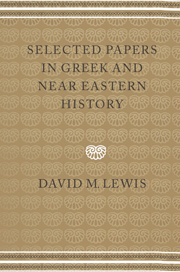Book contents
- Frontmatter
- Contents
- List of plates
- Preface
- Systems of reference
- GENERAL
- ATHENIAN
- 9 Public property in the city
- 10 Cleisthenes and Attica
- 11 Review of J. S. Traill, The Political Organization of Attica
- 12 Review of P. Siewert, Die Trittyen Attikas und die Heeresreform des Kleisthenes
- 13 The Kerameikos ostraka
- 14 Megakles and Eretria
- 15 The Athenian Coinage Decree
- 16 Athena's robe
- 17 The treaties with Leontini and Rhegion
- 18 Entrenchment-clauses in Attic decrees
- 19 Apollo Delios
- 20 After the profanation of the Mysteries
- 21 Aristophanes and politics
- 22 Who was Lysistrata?
- 23 A note on IG i2114 [= i3105]
- 24 The epigraphical evidence for the end of the Thirty
- 25 The financial offices of Eubulus and Lycurgus
- 26 The dating of Demosthenes' speeches
- 27 Law on the Lesser Panathenaia
- 28 The Athenian Rationes Centesimarum
- 29 The chronology of the Athenian New Style Coinage
- 30 Review of M. Thompson, The New Style Silver Coinage of Athens
- NEAR EASTERN
- Bibliography
- Publications of David M. Lewis
- Indexes
11 - Review of J. S. Traill, The Political Organization of Attica
A Study of the Demes, Trittyes, and Phylai, and their Representation in the Athenian Council
Published online by Cambridge University Press: 15 January 2010
- Frontmatter
- Contents
- List of plates
- Preface
- Systems of reference
- GENERAL
- ATHENIAN
- 9 Public property in the city
- 10 Cleisthenes and Attica
- 11 Review of J. S. Traill, The Political Organization of Attica
- 12 Review of P. Siewert, Die Trittyen Attikas und die Heeresreform des Kleisthenes
- 13 The Kerameikos ostraka
- 14 Megakles and Eretria
- 15 The Athenian Coinage Decree
- 16 Athena's robe
- 17 The treaties with Leontini and Rhegion
- 18 Entrenchment-clauses in Attic decrees
- 19 Apollo Delios
- 20 After the profanation of the Mysteries
- 21 Aristophanes and politics
- 22 Who was Lysistrata?
- 23 A note on IG i2114 [= i3105]
- 24 The epigraphical evidence for the end of the Thirty
- 25 The financial offices of Eubulus and Lycurgus
- 26 The dating of Demosthenes' speeches
- 27 Law on the Lesser Panathenaia
- 28 The Athenian Rationes Centesimarum
- 29 The chronology of the Athenian New Style Coinage
- 30 Review of M. Thompson, The New Style Silver Coinage of Athens
- NEAR EASTERN
- Bibliography
- Publications of David M. Lewis
- Indexes
Summary
This volume grew out of the work now published as Athenian Agora xv, The Athenian Councillors, which contains its primary epigraphic evidence. It effectively replaces a great deal of earlier work, and will be needed wherever Athenian institutions are studied.
Traill establishes that the number of constitutional demes in Cleisthenes‘ system was 139. One new deme was created on or soon after the foundations of each of the tribes Ptolemais, Attalis and Hadrianis. Other demes attested in ancient evidence or hypothesised by scholars are discussed and rejected, except for some used quasi-officially in lists of the Roman period.
The evidence here collected suffices to establish the representation of these demes in the Council until about 200 BC. The evidence is still unsatisfactory for the tribe Kekropis, and figures for Hippothontis before 307 BC have to be partly inferred from later evidence. There was no redistribution of representation until the foundation of the Macedonian tribes in 307 BC. After 200 BC fixed quotas of representation were abolished.
Traill makes a substantial attempt to determine the relation of representation to actual population; a similar, more speculative, treatment, not used by him, has been made by P. J. Bicknell, Studies in Athenian Politics and Genealogy (Historia Einzelschrift 19,1972). Apart from some rather doubtful evidence from ephebe–lists, the comparison still has to be with tables based on Kirchner's Prosopographia Attica of 1898–1901. Traill points out some ways in which these tables could be misleading, and more could be added; I do not think the comparison serves more than very general purposes.
- Type
- Chapter
- Information
- Selected Papers in Greek and Near Eastern History , pp. 99 - 101Publisher: Cambridge University PressPrint publication year: 1997



